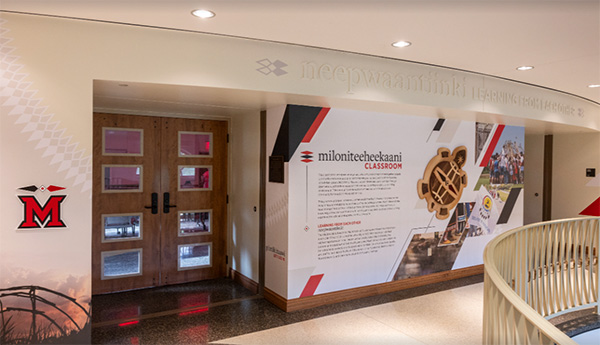Miami Tribe of Oklahoma chief and Miami University president come together to celebrate new learning space
The MacMillan Hall classroom was a gift from Miami University to the Tribe in 2022 to commemorate their unique 50-year relationship

Miami Tribe of Oklahoma chief and Miami University president come together to celebrate new learning space

They call it miloniteeheekaani, which means “the Myaamia classroom.”
Miami University President Gregory Crawford and Miami Tribe of Oklahoma Chief Douglas Lankford on Friday celebrated the latest step in the relationship between the two entities: a new learning space at the heart of the Oxford campus.
The university gifted the classroom space to the Miami Tribe in 2022 as part of the 50th anniversary commemorating the unique relationship between the sovereign tribal nation and the public university.
“The Love and Honor this university shows to our people is just unbelievable,” Chief Lankford said before joining other Tribe leaders; President Crawford; Dr. Renate Crawford, Miami’s university ambassador; and Kara Strass, director of Miami Tribe Relations, in cutting the ribbon outside the second-floor classroom in MacMillan Hall.
'We are one'
President Crawford called the classroom at the top of the stairs, also known as the Great Room, “another piece of this history we share with the Tribe. We are one; we are together.”
A culturally significant turtle made from maple, walnut, and cherry that was created by tribal artist Jody Gamble graces the wall outside the classroom.
The transformed classroom space includes several Myaamia words or phrases and their English translations on the walls. They include kiiloona myaamiaki, which means “We are Miami," myaamionki, which means “Myaamia homelands,” and tapaalintioni nahiteehioni, which means “Love and Honor.”
Mood lighting in the raised ceiling can feature multiple colors, including shades of red to resemble light illuminating from a burning fire. Fire, as captured in the Myaamia Heritage Logo, is symbolic of the warmth of the partnership and recognition of the shared responsibility needed to “tend the fire” to continue nurturing the relationship.
Over time, the relationship has grown stronger, with steps that have included Miami’s Land Acknowledgement saying Miami is located within the traditional homelands of the Myaamia and Shawnee people. The Miami people were forcibly removed from their homelands in 1846.

Neepwaantiinki, 'learning from each other'
The relationship led to the creation of the Myaamia Center at Miami University in 2001. The Tribe’s research arm is dedicated to the revitalization of Miami language and culture and to restoring that knowledge to the Myaamia people.
President Crawford told those who gathered for the classroom ribbon cutting, “People ask me all the time, why does it work so well at Miami? I think it really boils down to one word: neepwaantiinki. That word means ‘learning from each other,’ and I think that’s what makes this relationship so special.”
Chief Lankford said, “As a nation, we can’t say enough about this university and the people who are here. Our language would not be where it is. Our culture would not be where it is. None of these things — they might exist — but nothing like what we have today without the help and support of this university.”
Inside the Myaamia classroom, President Crawford joined Chief Lankford and dozens of others in watching the first installment of a docuseries about the Tribe and its relationship with Miami. More installments, created by Miami Online, are planned.